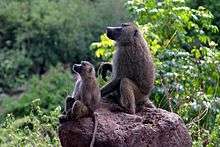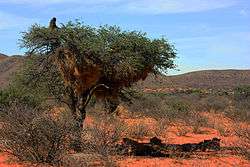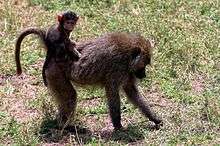Baboon
| Baboons[1] Temporal range: 2.0–0 Ma Early Pleistocene – Recent | |
|---|---|
.jpg) | |
| Olive baboon | |
| | |
| Yellow baboon calls recorded in Kenya | |
| Scientific classification | |
| Kingdom: | Animalia |
| Phylum: | Chordata |
| Class: | Mammalia |
| Order: | Primates |
| Suborder: | Haplorhini |
| Family: | Cercopithecidae |
| Tribe: | Papionini |
| Genus: | Papio Erxleben, 1777 |
| Type species | |
| Simia hamadryas Linnaeus, 1758 | |
| Species | |
|
Papio hamadryas | |
| Synonyms | |
| |
Baboons are African and Arabian Old World monkeys belonging to the genus Papio, part of the subfamily Cercopithecinae. The five species are some of the largest non-hominoid members of the primate order; only the mandrill and the drill are larger. Previously, the closely related gelada (genus Theropithecus) and the two species (mandrill and drill) of genus Mandrillus were grouped in the same genus, and these Old World monkeys are still often referred to as baboons in everyday speech. They range in size and weight depending on species. The Guinea baboon is 50 cm (20 in) and weighs only 14 kg (31 lb), while the largest chacma baboon can be 120 cm (47 in) and weigh 40 kg (88 lb).
Taxonomy and phylogeny
Five species of Papio are commonly recognized, although there is some disagreement about whether they are really full species or subspecies. They are P. ursinus (chacma baboon, found in southern Africa), P. papio (western, red, or Guinea baboon, found in the far western Africa), P. hamadryas (hamadryas baboon, found in the Horn of Africa and southwestern Arabia), P. anubis (olive baboon, found in the north-central African savanna) and P. cynocephalus (yellow baboon, found in south-central and eastern Africa). Many authors distinguish P. hamadryas as a full species, but regard all the others as subspecies of P. cynocephalus and refer to them collectively as "savanna baboons". This may not be helpful: it is based on the argument that the hamadryas baboon is behaviorally and physically distinct from other baboon species, and that this reflects a separate evolutionary history. However, recent morphological and genetic studies of Papio show the hamadryas baboon to be more closely related to the northern baboon species (the Guinea and olive baboons) than to the southern species (the yellow and chacma baboons).[2][3][4]
In 2015 researchers found the oldest baboon fossil dating 2 million years ago.[5]
The traditional five-form classification probably under-represents the variation within Papio. Some commentators[6] argue that at least two more forms should be recognized, including the tiny Kinda baboon (P. cynocephalus kindae) from Zambia, DR Congo, and Angola, and the gray-footed baboon (P. ursinus griseipes) found in Zambia, Botswana, Zimbabwe, Mozambique, and northern South Africa. However, current knowledge of the morphological, genetic, and behavioral diversity within Papio is too poor to make any final, comprehensive judgment on this matter.
The five species of baboons in the genus Papio are:[1]
- Genus Papio
- Hamadryas baboon, Papio hamadryas
- Guinea baboon, Papio papio
- Olive baboon, Papio anubis
- Yellow baboon, Papio cynocephalus
- Central yellow baboon, Papio cynocephalus cynocephalus
- Ibean baboon, Papio cynocephalus ibeanus
- Kinda baboon, Papio cynocephalus kindae
- Chacma baboon, Papio ursinus
- Cape chacma, Papio ursinus ursinus
- Gray-footed chacma, Papio ursinus griseipes
- Ruacana chacma, Papio ursinus raucana
Anatomy and physiology

All baboons have long, dog-like muzzles, heavy, powerful jaws with sharp canine teeth, close-set eyes, thick fur except on their muzzles, short tails, and rough spots on their protruding buttocks, called ischial callosities. These calluses are nerveless, hairless pads of skin that provide for the sitting comfort of the baboon.
All baboon species exhibit pronounced sexual dimorphism, usually in size, but also sometimes in colour or canine development. Males of the hamadryas baboon species also have large white manes.
Behavior and ecology

Baboons are terrestrial (ground dwelling) and are found in open savannah, open woodland and hills across Africa. Their diets are omnivorous, but mostly herbivorous, yet they eat insects and occasionally prey on fish, trout and salmon if available, shellfish, hares, birds, vervet monkeys, and small antelopes.[7] They are foragers and are active at irregular times throughout the day and night. They can raid human dwellings, and in South Africa, they have been known to prey on sheep and goats.
Baboons in captivity have been known to live up to 45 years, while in the wild their life expectancy is about 30 years.
Baboons are able to acquire orthographic processing skills, which form part of the ability to read.[8]
Predators
Their principal predators are Nile crocodiles, lions, spotted and striped hyenas, leopards and cheetahs.[9] They are considered a difficult prey for the leopard, though, which is mostly a threat to young baboons. Large males will often confront them by flashing their eyelids, showing their teeth by yawning, screeching, making gestures, and chasing after the intruder/predator. Although they are not a prey species, baboons have been killed by the black mamba. This usually occurs when a baboon accidentally rouses the snake.[10]
-

Baboons caught up a tree by Kalahari lions (1 of 3)
-

Baboons caught up a tree by Kalahari lions (2 of 3)
-

Baboons caught up a tree by Kalahari lions (3 of 3)
Social systems

Most baboons live in hierarchical troops. Group sizes vary between five and 250 animals (often about 50 or so), depending on specific circumstances, especially species and time of year. The structure within the troop varies considerably between hamadryas baboons and the remaining species, sometimes collectively referred to as savanna baboons. The hamadryas baboons often appear in very large groups composed of many smaller harems (one male with four or so females), to which females from elsewhere in the troop are recruited while they are still too young to breed. Other baboon species have a more promiscuous structure with a strict dominance hierarchy based on the matriline. The hamadryas baboon group will typically include a younger male, but he will not attempt to mate with the females unless the older male is removed.
Baboons can determine from vocal exchanges what the dominance relations are between individuals. When a confrontation occurs between different families or where a lower-ranking baboon takes the offensive, baboons show more interest in this exchange than those between members of the same family or when a higher-ranking baboon takes the offensive. This is because confrontations between different families or rank challenges can have a wider impact on the whole troop than an internal conflict in a family or a baboon reinforcing its dominance.[11]
The collective noun for baboons is commonly "troop".[12]
In the harems of the hamadryas baboons, the males jealously guard their females, to the point of grabbing and biting the females when they wander too far away. Despite this, some males will raid harems for females. Such situations often cause aggressive fights by the males. Visual threats are usually accompanied by these aggressive fights. This would include a quick flashing of the eyelids accompanied by a yawn to show off the teeth. Some males succeed in taking a female from another's harem, called a "takeover". In many species, infant baboons are taken by the males as hostages during fights.
Mating and birth

Baboon mating behavior varies greatly depending on the social structure of the troop. In the mixed groups of savanna baboons, each male can mate with any female. The mating order among the males depends partially on their social ranking, and fights between males are not unusual. There are, however, more subtle possibilities; in mixed groups, males sometimes try to win the friendship of females. To garner this friendship, they may help groom the female, help care for her young, or supply her with food. The probability is high that those young are their offspring. Some females clearly prefer such friendly males as mates. However, males will also take infants during fights to protect themselves from harm.
A female initiates mating by presenting her swollen rump to the male's face.[13]
Females typically give birth after a six-month gestation, usually to a single infant. The young baboon weighs approximately 400 g and has a black epidermis when born. The females tend to be the primary caretaker of the young, although several females will share the duties for all of their offspring.
After about one year, the young animals are weaned. They reach sexual maturity in five to eight years. Baboon males leave their birth group, usually before they reach sexual maturity, whereas females are philopatric and stay in the same group their whole lives.
Relationship with humans
In Egyptian mythology, Babi was the deification of the hamadryas baboon and was therefore a sacred animal. It was known as the attendant of Thoth, so is also called the sacred baboon.
Diseases
Herpesvirus papio family of viruses and strains infect baboons. Their effects on humans are unknown.
See also
References
- 1 2 Groves, C.P. (2005). "GENUS Papio". In Wilson, D.E.; Reeder, D.M. Mammal Species of the World: A Taxonomic and Geographic Reference (3rd ed.). Baltimore: Johns Hopkins University Press. pp. 166–167. OCLC 62265494. ISBN 0-801-88221-4.
- ↑ Newman TK, Jolly CJ, Rogers J (2004). "Mitochondrial phylogeny and systematics of baboons (Papio)". American Journal of Physical Anthropology. 124 (1): 17–27. doi:10.1002/ajpa.10340. PMID 15085544.
- ↑ Frost SR, Marcus LF, Bookstein FL, Reddy DP, Delson E (2003). "Cranial allometry, phylogeography, and systematics of large-bodied papionins (Primates:Cercopithecinae) inferred from geometric morphometric analysis of landmark data". Anatomical Record. 275 (2): 1048–1072. doi:10.1002/ar.a.10112. PMID 14613306.
- ↑ Wildman DE, Bergman TJ, al-Aghbari A, Sterner KN, Newman TK, Phillips-Conroy JE, Jolly CJ, Disotell TR (2004). "Mitochondrial evidence for the origin of hamadryas baboons.". Molecular Phylogenetics and Evolution. 32 (1): 287–296. doi:10.1016/j.ympev.2003.12.014. PMID 15186814.
- ↑ http://www.livescience.com/51937-earliest-baboon-fossil.html
- ↑ Jolly, CJ (1993). "Species, subspecies, and baboon systematics". In WH Kimbel; LB Martin. Species, Species Concepts, and Primate Evolution. New York: Plenum Press.
- ↑ "AWF: Wildlife: Baboon". African Wildlife Foundation. Archived from the original on 17 September 2008. Retrieved 2008-08-18.
- ↑ Jonathan Grainger; Stéphane Dufau; Marie Montant; Johannes C. Ziegler; Joël Fagot (2012). "Orthographic processing in baboons (Papio papio)". Science. 336 (6078): 245–248. doi:10.1126/science.1218152. PMID 22499949.
- ↑ "AWF: Wildlife: Baboon". African Wildlife Foundation.
- ↑ Bauchot, Roland (2006). Snakes: A Natural History. Sterling. pp. 41,76,176. ISBN 978-1-4027-3181-5.
- ↑ Bergman TJ, Beehner JC, Cheney DL, Seyfarth RM (2003). "Hierarchical classification by rank and kinship in baboons". Science. 302 (November 14): 1234–1236. doi:10.1126/science.1087513. PMID 14615544.
- ↑ "OED Collective nouns". Retrieved 2006-11-26.
- ↑ Altmann, J.; Hausfater, G.; Altmann, S. A. (1988). "Determinants of reproductive success in savannah baboons, Papio cynocephalus". In Clutton-Brock T. H. Reproductive success: studies of individual variation in contrasting breeding systems. Chicago (IL): University Chicago Press. pp. 403–418.
Further reading
- Cheney, Dorothy L.; Seyfarth, Robert M. (2007). Baboon Metaphysics: The Evolution of a Social Mind. Chicago: University of Chicago Press. ISBN 9780226102436.
- Zinner, Dietmar; Groeneveld, Linn F.; Keller, Christina; Roos, Christian (2009). "Mitochondrial phylogeography of baboons (Papio spp.) – Indication for introgressive hybridization?". BMC Evolutionary Biology. 9 (83): 83. doi:10.1186/1471-2148-9-83.
External links
| Wikispecies has information related to: Papio |
| Wikimedia Commons has media related to Baboon. |
| Wikiquote has quotations related to: Baboons |
| Wikisource has the text of the 1911 Encyclopædia Britannica article Baboon. |
- Baboons: Wildlife summary from the African Wildlife Foundation
- Primate Info Net Papio Factsheets
- Stress and Coping What baboons can teach us Lecture by Robert Sapolsky at Stanford University (via iTunes)